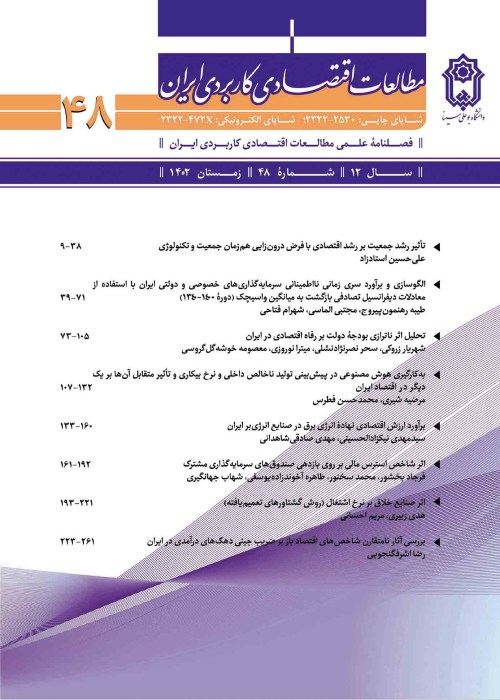Estimation of the Marginal CO2 abatement costs for workshops with 10 employees and more in Iran: whit shadow price approach
Author(s):
Abstract:
One of the biggest global challenges related to environmental pollution is the climate change induced mainly by anthropogenic emissions of CO2 and other greenhouse gases (GHG). Human activities since the beginning of the Industrial Revolution (taken as the year 1750) have produced a 40% increase in the atmospheric concentration of carbon dioxide . This increase has occurred despite the uptake of a large portion of the emissions by various natural "sinks" involved in the carbon cycle. Anthropogenic carbon dioxide (CO2) emissions (i.e., emissions produced by human activities) come from combustion of fossil fuels, principally coal, oil, and natural gas, along with deforestation, soil erosion and animal agriculture.
One of the most important sources of the emission of greenhouse gases, especially carbon dioxide, is a variety of activities in important economic sectors, while one of the leading parts in carbon emissions is industry. In this study, using input- and output-based distance functions, the Marginal CO2 Abatement Costs as one of the most important greenhouse gases emitted during the development of industry sector of Iranian economy was measured for industrial workshops having 10 workers or more in the years 2008 to 2013. The analytical framework for shadow price estimation consists of three main steps, i.e. constructing an environmental production technology by distance function, deriving the shadow-pricing formula, and formulating a econometric model to compute the shadow prices. using Stata software 13, and tests Chow, Hausman and Pagan tests reveals that the models proposed in this study, of which type of pool or fixed and random effects model. We used sfpanel command to parameter estimation due inefficiency component of the model. The estimation is done based on maximum likelihood method. At the end of using the results of parameter estimation, marginal CO2 abatement costs is calculated for each industry sub-sectors. In this regard, after gathering the required data, the concept of shadow price of emission of this pollutant was used. The results show that different industrial subsectors have different Marginal CO2 Abatement Costs and the trend of Marginal CO2 Abatement Costs have increased dramatically during the study period for the industrial sector in such a way that the calculated shadow price in 2013 has grown 221 percent comparing to 2008. Also, the different results from two types of distance function which are used in this study show that the choice of method or model used to estimate the shadow price is of utmost importance.
One of the most important sources of the emission of greenhouse gases, especially carbon dioxide, is a variety of activities in important economic sectors, while one of the leading parts in carbon emissions is industry. In this study, using input- and output-based distance functions, the Marginal CO2 Abatement Costs as one of the most important greenhouse gases emitted during the development of industry sector of Iranian economy was measured for industrial workshops having 10 workers or more in the years 2008 to 2013. The analytical framework for shadow price estimation consists of three main steps, i.e. constructing an environmental production technology by distance function, deriving the shadow-pricing formula, and formulating a econometric model to compute the shadow prices. using Stata software 13, and tests Chow, Hausman and Pagan tests reveals that the models proposed in this study, of which type of pool or fixed and random effects model. We used sfpanel command to parameter estimation due inefficiency component of the model. The estimation is done based on maximum likelihood method. At the end of using the results of parameter estimation, marginal CO2 abatement costs is calculated for each industry sub-sectors. In this regard, after gathering the required data, the concept of shadow price of emission of this pollutant was used. The results show that different industrial subsectors have different Marginal CO2 Abatement Costs and the trend of Marginal CO2 Abatement Costs have increased dramatically during the study period for the industrial sector in such a way that the calculated shadow price in 2013 has grown 221 percent comparing to 2008. Also, the different results from two types of distance function which are used in this study show that the choice of method or model used to estimate the shadow price is of utmost importance.
Keywords:
Language:
Persian
Published:
Quarterly Journal of Applied Economics Studiesin Iran, Volume:6 Issue: 23, 2017
Pages:
137 to 159
magiran.com/p1756170
دانلود و مطالعه متن این مقاله با یکی از روشهای زیر امکان پذیر است:
اشتراک شخصی
با عضویت و پرداخت آنلاین حق اشتراک یکساله به مبلغ 1,390,000ريال میتوانید 70 عنوان مطلب دانلود کنید!
اشتراک سازمانی
به کتابخانه دانشگاه یا محل کار خود پیشنهاد کنید تا اشتراک سازمانی این پایگاه را برای دسترسی نامحدود همه کاربران به متن مطالب تهیه نمایند!
توجه!
- حق عضویت دریافتی صرف حمایت از نشریات عضو و نگهداری، تکمیل و توسعه مگیران میشود.
- پرداخت حق اشتراک و دانلود مقالات اجازه بازنشر آن در سایر رسانههای چاپی و دیجیتال را به کاربر نمیدهد.
In order to view content subscription is required
Personal subscription
Subscribe magiran.com for 70 € euros via PayPal and download 70 articles during a year.
Organization subscription
Please contact us to subscribe your university or library for unlimited access!



